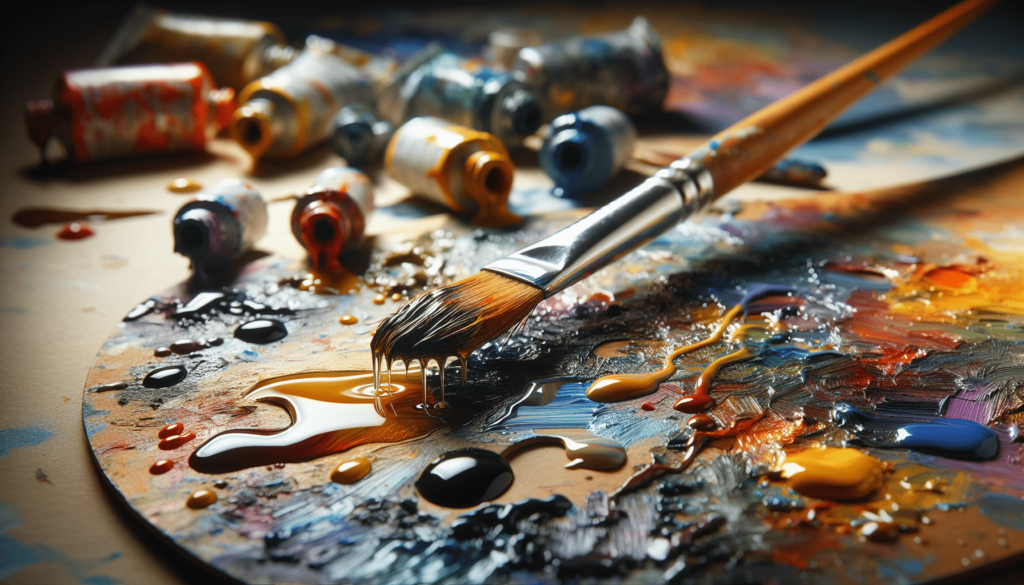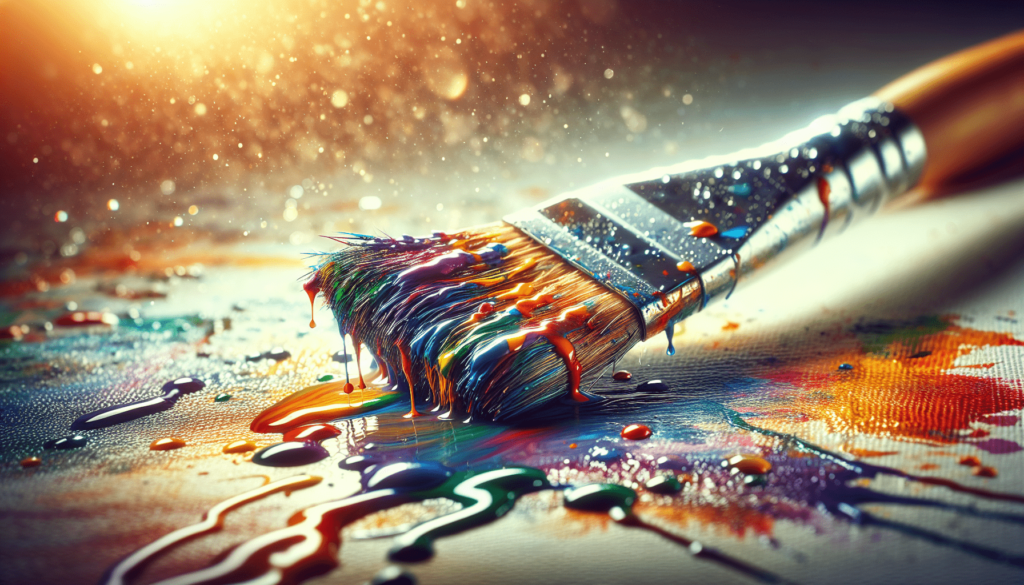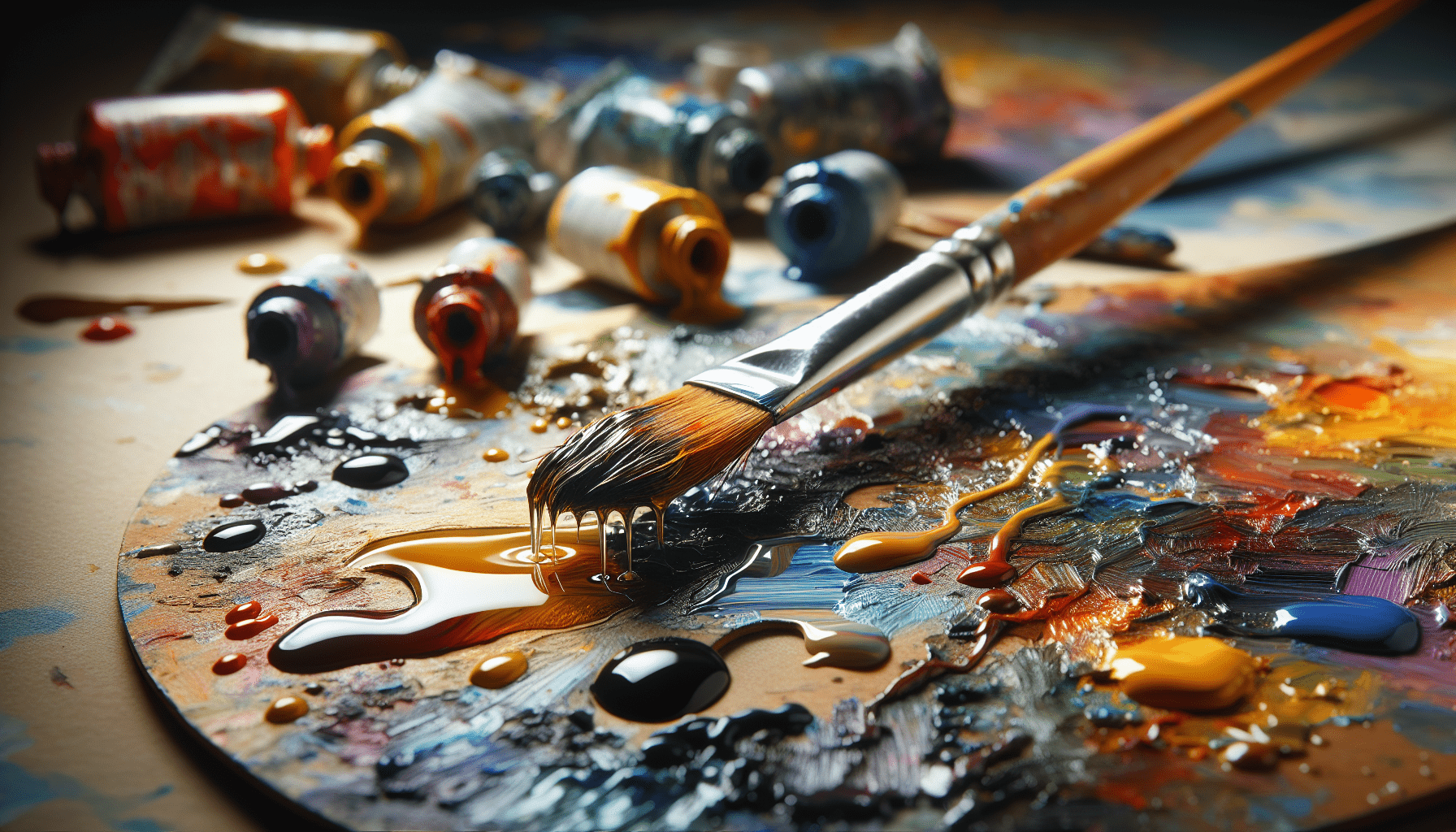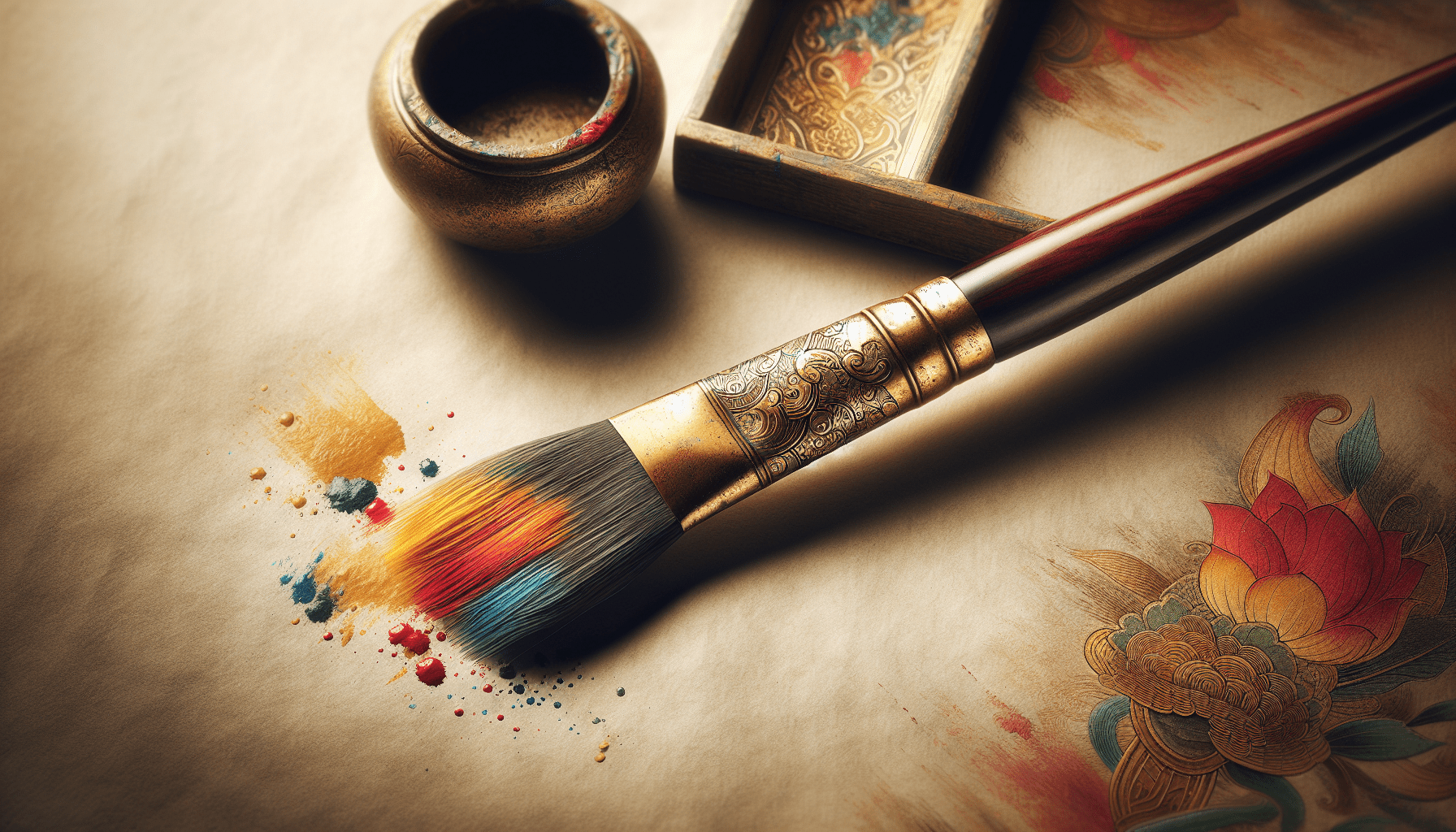In the world of painting, one might wonder if using a wet paint brush is a viable technique. While it may seem counterintuitive, there are indeed scenarios where utilizing a wet paint brush can yield remarkable results. By dampening the bristles, artists are able to achieve smoother and more blended strokes, creating a beautiful transition of colors. However, it is important to understand the nuances of this method, as using a wet paint brush requires careful consideration of factors such as paint consistency and paper type. So, if you’re ready to explore the potential of a wet paint brush, let’s discover the possibilities together.

Benefits of Using a Wet Paint Brush
Preventing paint from drying out
Using a wet paintbrush has the primary benefit of preventing the paint from drying out too quickly. When painting with watercolor, acrylic, or oil-based paints, keeping the brush moist allows for a longer working time. This is particularly important when working on larger surfaces or when trying to achieve specific brushstroke effects. By keeping the paint wet, you have more control over its consistency and can achieve smoother, more even results.
Smooth and even application
Another advantage of using a wet paintbrush is that it helps to achieve a smoother and more even application of the paint. When the brush is damp, the paint flows more easily and is less likely to leave streaks or uneven patches on the surface. This is especially important when working with transparent or translucent paints, as any unevenness in application can be more visible. By using a wet brush, you can ensure that each stroke of paint is applied evenly for a professional-looking finish.
Blending colors
Using a wet paintbrush also makes it easier to blend colors together on the canvas. By keeping the brush damp, you can easily mix different hues on the palette and then blend them together directly on the surface. This is particularly useful for creating gradients or smooth transitions between different shades. Whether you are working with watercolor, acrylic, or oil-based paints, a wet brush allows for seamless color blending and helps to achieve subtle variations in tone.
Easier cleanup
One additional benefit of using a wet paintbrush is that it makes the cleanup process much easier. Since the brush remains moist during the painting process, the paint is less likely to dry and harden on the bristles. This means that when you are finished painting, you can simply rinse the brush under water and remove any remaining paint. Cleaning a wet brush is quicker and more efficient compared to trying to remove dried paint from the bristles. By properly cleaning your brushes after each use, you can extend their lifespan and maintain their effectiveness.
Painting Techniques Using a Wet Brush
Wet-on-Wet
The wet-on-wet technique is a popular method used by artists to create soft and blended backgrounds or to apply wet layers of paint onto an already wet surface. By using a wet brush to apply wet paint onto wet paper or canvas, you can achieve beautiful and ethereal effects. The wet paint easily spreads and blends together, allowing for seamless transitions between colors. This technique is commonly used in watercolor painting but can also be applied in acrylic and oil painting.
Wash
A wash technique involves applying a thin and transparent layer of paint over a large area. By using a wet brush and diluting the paint with water or medium, you can create a wash that covers the surface with a consistent and even tone. This technique is often used to establish a base color or create atmospheric effects. With a wet brush, you can easily control the dilution of the paint and achieve the desired level of transparency for your wash.
Glazing
Glazing is a technique that involves applying thin layers of translucent paint over a previously dried layer. By using a wet brush, you can easily blend the glaze with the underlying layers, creating a smooth and luminous effect. The wet brush helps to keep the glaze moist and workable, allowing for controlled application. This technique is commonly used in oil painting to add depth and dimension to a painting.
Blending
Blending colors is an essential technique in painting, and using a wet brush facilitates the blending process. By wetting the brush before picking up the paint, you can easily mix and merge colors together on the palette or directly on the canvas. This allows for smoother transitions between colors and helps to create a more realistic and harmonious representation. Whether you are blending colors in a landscape, portrait, or still life, a wet brush is an effective tool for achieving seamless color gradations.
Paint Types Suitable for Wet Brush Usage
Watercolor
Watercolor paints are known for their transparency and ability to be easily manipulated when wet. By using a wet brush, watercolor artists can keep the paints moist and achieve the desired consistency. The wet brush helps the watercolor pigments spread evenly on the paper, allowing for smooth and subtle color transitions. Additionally, watercolor painting often involves wet-on-wet techniques, where a wet brush is necessary to achieve the desired effects.
Acrylic
Acrylic paints are versatile and can be used with both wet and dry brushes. However, using a wet brush with acrylics allows for smoother application and easier color blending. Acrylic paints dry quickly, but by keeping the brush moist, you can extend the working time and manipulate the paint more effectively. The wet brush also helps to avoid brush strokes and achieve a more even finish. Whether you are using acrylics for fine art or craft projects, a wet brush enhances the painting experience.
Oil-based
Oil-based paints have a longer drying time compared to watercolor and acrylics, making them suitable for use with wet brushes. By keeping the brush constantly moist, artists can achieve smooth and blended brushstrokes. The wet brush also allows for better control when working with oil paints, as it helps the paint glide smoothly on the canvas and blend with other colors. The wet brush technique is particularly beneficial when using glazing or layering techniques in oil painting.
Preparation Before Using a Wet Brush
Clean your brush
Before using a wet brush, it is important to ensure that it is clean and free from any old paint residue. Cleaning your brush properly extends its lifespan and prevents any unwanted mixing of colors. Rinse the brush under warm water until the water runs clear, gently squeezing the bristles to remove any trapped paint. Use a mild soap or brush cleaner if necessary, and reshape the bristles with your fingers. Properly cleaning your brush before each use ensures that the paint applies smoothly and reduces the risk of any unwanted texture or color contamination.
Moisten the brush
To prepare your wet brush for painting, you need to moisten it. Dip the brush into water or a suitable medium depending on the type of paint you’re using. The goal is to dampen the bristles without saturating them. You want the brush to be moist enough to keep the paint workable, but not so wet that it dilutes the paint excessively. If using watercolor, be mindful of the paper’s absorbency and adjust the amount of water accordingly. By moistening the brush, you ensure smoother paint application and make it easier to blend colors.
Prepare your palette and paint
Before you start painting, it’s crucial to set up your palette and prepare your paint. For watercolor or acrylics, squeeze out a small amount of each color onto your palette, leaving enough space between them for mixing. For oil painting, you can dispense small amounts of oil paint directly onto your palette. Having all your colors and mediums ready before starting ensures that you can work efficiently without interruptions. Consider the color scheme you want to achieve and plan your palette arrangement accordingly. By preparing your palette and paint in advance, you can focus on painting without the need to stop and fetch more supplies.

Limitations of Using a Wet Paint Brush
Not suitable for certain surfaces
While using a wet paintbrush offers many benefits, it is not suitable for all surfaces. Some materials may react adversely to moisture, causing warping or discoloration. For example, delicate watercolor paper can easily buckle and become damaged if excessively wet. It’s important to consider the surface you are working with and adjust your painting techniques accordingly. In some instances, such as when working on surfaces like glass or metal, a wet brush may not adhere well, and alternative painting methods should be used.
May dilute water-soluble paints
Using a wet brush with water-soluble paints, such as watercolors or certain types of gouache, may cause them to be diluted more than desired. This can result in lighter, less vibrant colors than intended. This is not always a disadvantage, as diluted washes and subtle variations can be desirable in certain artistic styles. However, if you aim for more intense colors or precise color mixtures, it is important to carefully control the moisture level of your brush and avoid excessive dilution.
Requires extra care and precision
Using a wet paintbrush requires a certain level of care and precision. It’s important to maintain control over the amount of moisture in the brush to achieve the desired effects. Too much water can cause paint to become too diluted or runny, while too little moisture can result in dry and stiff brushstrokes. Practice and experience can help you develop the necessary skills to handle a wet brush effectively. By paying attention to the moisture levels and being mindful of your technique, you can overcome the limitations and master the use of a wet paintbrush.
Common Mistakes to Avoid with a Wet Paint Brush
Using too much water
One common mistake when using a wet paintbrush is using too much water. Excessive moisture can lead to diluted or runny paint, resulting in a lack of color intensity and control. To avoid this mistake, be mindful of the amount of water you use to moisten your brush. Start with a small amount and gradually increase if necessary. It’s better to add more water slowly than to have to deal with paint that is too watery right from the beginning.
Failing to clean the brush properly
Properly cleaning your brush before and after each use is essential, especially when using a wet paintbrush. Leaving old paint residue on the brush can lead to color contamination and affect the outcome of your painting. Take the time to thoroughly clean your brush, removing all traces of paint. Rinse it under warm water, gently squeeze out excess moisture, and reshape the bristles. By maintaining clean brushes, you ensure better paint application and preserve the lifespan of your brushes.
Using incompatible paints
Using incompatible paints with a wet brush can lead to undesirable results. For example, using watercolor paints over an oil-based layer can cause the colors to blend in an unintended way or even repel each other. It’s important to be aware of the compatibility of different paint types and choose appropriate painting techniques accordingly. If you intend to work with different paint types in one piece, make sure you understand their properties and plan the sequence of application accordingly.
Not controlling moisture levels
Controlling the moisture level of your brush is crucial for achieving the desired effects. Too much moisture can cause the paint to become too diluted, while too little moisture can result in dry and stiff brushstrokes. Take the time to adjust the moisture level of your brush according to the type of paint you are using and the desired outcome. Practice and experiment with different moisture levels to develop a sense of control and achieve the best results with your wet paintbrush.
Tips for Using a Wet Paint Brush Effectively
Maintain a damp brush
To use a wet paintbrush effectively, it’s important to maintain a damp brush throughout the painting process. This ensures that the paint remains workable and that you have control over its application. Keep a container of clean water nearby and periodically moisten your brush as needed. Be mindful of not letting your brush become too wet, as this can lead to excessive dilution of the paint. By maintaining a damp brush, you can achieve more fluid brushstrokes and better control over the paint.
Use appropriate brush sizes
When using a wet brush, it’s important to consider the appropriate brush size for the task at hand. Smaller brushes are ideal for fine details or tight areas, while larger brushes are better suited for broader strokes or covering larger areas. Choose a brush size that matches your intended application and the size of your canvas or surface. Using the right brush size ensures better control and efficiency in your painting process.
Experiment with brush techniques
Using a wet brush opens up a variety of brush techniques that can enhance your paintings. Experiment with different brushstrokes, such as dry brushing, stippling, or glazing, to achieve various textures and effects. Get familiar with the capabilities of your brush and explore different ways to apply the paint. By experimenting with brush techniques, you can expand your artistic repertoire and create unique and captivating artwork.
Take breaks to clean and moisten the brush
During longer painting sessions, it’s important to take breaks to clean and moisten your brush. As the paint dries out on the bristles, it can affect the quality of your brushstrokes. Take a moment to rinse your brush under water, gently squeezing out any trapped paint. Then reshape the bristles and moisten the brush before returning to your painting. By taking breaks to clean and moisten your brush, you maintain its effectiveness and ensure consistent paint application.
Enhancing Paint Effects with a Wet Brush
Creating texture
Using a wet brush allows you to create texture in your paintings. By manipulating the damp brush on the canvas, you can produce various textural effects, such as stippling, scumbling, or dry brushing. The wet paint easily adheres to the textured surface, enabling you to achieve both subtle and pronounced effects. Whether you want to create the illusion of rough rock surfaces or delicate foliage, a wet brush can assist in adding textural depth to your artwork.
Producing watercolor wash effects
A wet brush is essential for producing watercolor wash effects. By moistening your brush and diluting the paint with water, you can create beautiful and translucent washes. Apply the wet paint onto wet paper, and watch as the colors blend and flow together, resulting in a vibrant and dynamic wash. The wet brush facilitates the flow of the paint and helps achieve the desired level of transparency. Experiment with different brush sizes and combinations of colors to create stunning watercolor wash effects.
Achieving soft edges
When working with wet paint and a wet brush, it is easier to achieve soft edges in your artwork. Soft edges create a sense of depth and atmosphere, and they can be particularly effective for creating realistic or ethereal scenes. By carefully controlling the moisture level in your brush, you can create gentle transitions between colors or create soft, feathered brushstrokes. With a wet brush, you can easily blend the paint and achieve the desired softness in your edges.
Adding depth and dimension
One of the advantages of using a wet brush is the ability to add depth and dimension to your paintings. By layering wet paint on top of wet paint, you can create a sense of depth and richness in your artwork. The wet paint readily blends with the underlying layers, allowing for smooth transitions and subtle variations in color and tone. This technique is particularly effective in oil painting, where glazing techniques can be used to build layers and create luminosity. With a wet brush, you can bring your paintings to life and add an extra level of visual interest.
Common Tools and Techniques for Drying a Wet Paint Brush
Blotting with a cloth or paper towel
If you need to remove excess moisture from your wet brush, a simple technique is to blot it with a cloth or paper towel. Gently press the bristles against the cloth or towel, which will absorb the excess water. Repeat the process until the brush reaches the desired level of dampness for your next painting step. Be careful not to press too hard, as this can damage the bristles. Blotting with a cloth or paper towel is a quick and effective way to control the moisture level of your wet brush.
Using a hairdryer
When time is of the essence and you need to dry your wet brush quickly, a hairdryer can be a useful tool. Set the hairdryer to a low or medium heat setting, and direct the airflow towards the bristles. Move the hairdryer evenly across the brush to ensure even drying. Be mindful of not holding the hairdryer too close to the brush, as excessive heat can damage the bristles or cause them to become stiff. Using a hairdryer can be particularly helpful when working with watercolor or acrylic paints, which dry relatively quickly.
Hanging the brush to air-dry
Allowing your wet brush to air-dry naturally is another method for drying it. After cleaning your brush, gently tap off any excess water and reshape the bristles. Hang the brush upside down in a well-ventilated area, using a brush holder or rack. This allows the bristles to dry naturally, with the water slowly evaporating. Hanging the brush to air-dry ensures that the bristles maintain their shape and elasticity. However, keep in mind that air-drying may take longer compared to other drying methods.
Using a brush holder or rack
A brush holder or rack is a convenient accessory for drying wet brushes and keeping them organized. These holders typically have slots or grooves to hold the brushes in an upright position, allowing the excess water to drip off and the bristles to dry evenly. Some brush holders also have a built-in ventilation system to facilitate faster drying. Using a brush holder or rack is recommended when working with numerous brushes or when you want to prevent the bristles from pressing against any surfaces and potentially getting deformed.
Frequently Asked Questions about Using a Wet Paint Brush
Can I reuse a wet paint brush the next day?
Yes, you can reuse a wet paintbrush the next day if you take proper care of it. After finishing your painting session, follow the necessary cleaning steps for your specific paint type. Rinse the brush thoroughly under water until the water runs clear, gently squeeze out excess moisture, and reshape the bristles. Then store the brush in a proper brush holder or wrap it in a damp cloth to keep it moist until the next use. By storing the wet brush properly, you can ensure that it remains pliable and ready to use in your next painting session.
How can I prevent my wet brush from drying out during breaks?
To prevent your wet brush from drying out during breaks, you have a few options. One method is to place your wet brush in a container filled with water, making sure that the bristles are fully submerged. This keeps the brush moist and prevents the paint from drying out. Alternatively, you can wrap your wet brush in a damp cloth or secure it in an airtight plastic bag to retain moisture. Both methods help to maintain a damp brush during breaks and ensure that your paint remains workable when you return to your artwork.
Is it better to use a wet or dry brush for blending colors?
Using a wet brush is generally preferred for blending colors. Wet brushes allow for smoother color transitions and easier blending of the pigments. The moisture in the brush helps the paint flow more easily, allowing you to achieve seamless gradations and soften edges. However, blending with a dry brush can also yield interesting effects, such as adding texture or creating distinct brushstroke marks. Ultimately, the choice between wet and dry brushes for blending depends on the desired outcome and the specific painting technique you are employing. Experimentation will help you discover the optimal approach for your artistic style.



